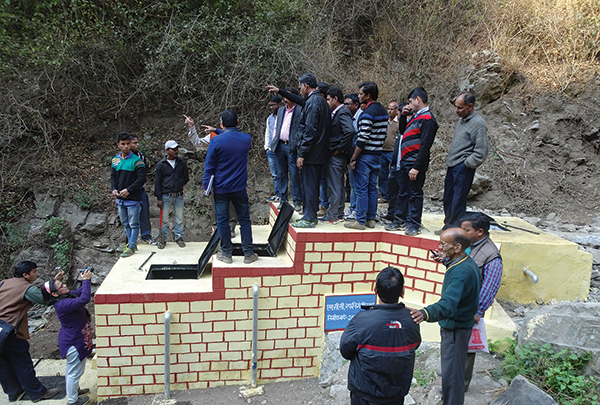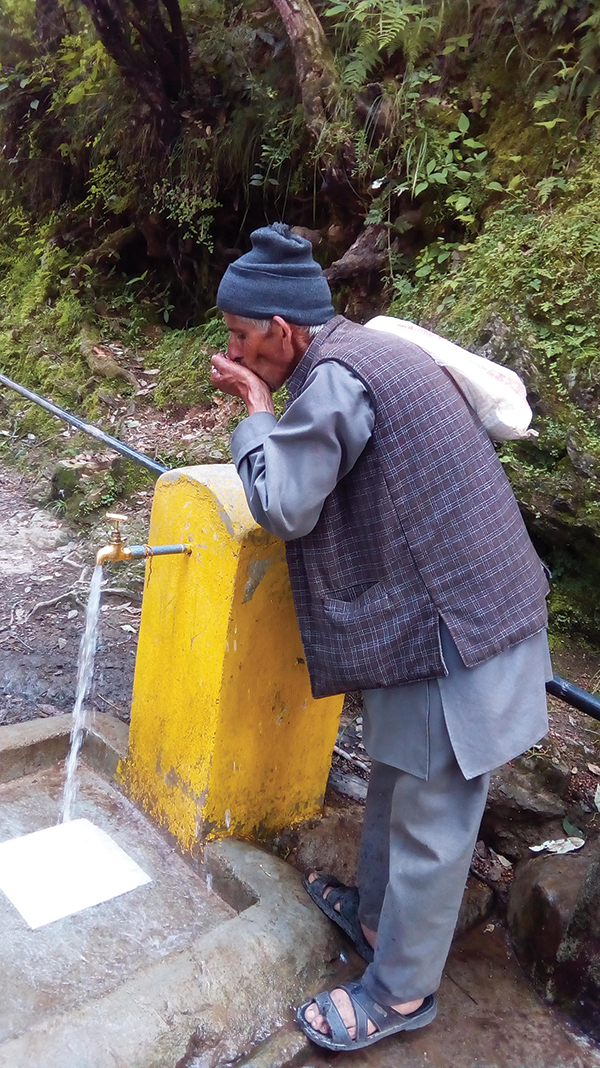“Water is the source of happiness, energy, health and piety, and is life giving as mother.” Rig Veda 10.9.1-2
“This Functional Household Tap Connection (FHTC) has delivered elixir to my house,” says Kamini Padiyar, a resident of village Kheda Talla, Tehri Garhwal, Uttarakhand. Water is considered an elixir in mountain areas of Uttarakhand, land of almighty rivers Ma Ganga and Yamuna. She further added, “My daughter attends her classes regularly and punctually.” Laxmi Devi, another lady from Kheda, says “Our village has become open defecation free and aware of personal hygiene, domestic hygiene and environmental sanitation.” Kamini and Laxmi are two happy women from over 60,000 families of 471 villages benefitted from Water & Sanitation program of Rural Development Institute, Himalayan Institute Hospital Trust over last 22 years.
Water is one of the prime and basic needs of all human beings. Rudimentary infrastructure for the provision of safe drinking water and sanitation is absent or inadequate in most of the hilly regions, which consist of sparsely populated clusters. This has direct impact on health and drudgery along with other multiple issues. Women have to increasingly spend more and more time, approximately 3-4 hours daily to fetch water from greater distances. Scarcity of drinking water is on the rise with steady decline of water sources. Therefore, Water & Sanitation is the subject of dedicated targets within the Sustainable Development Goal (SDG 6). Indeed, access to safe water and sanitation are human rights, as recognized in 2010 by the United Nations General Assembly. Today, worldwide 2.2 billion people lack access to safely managed drinking water services and 4.2 billion people lack safely managed sanitation services. The impact on child mortality rates is devastating with more than 297,000 children under five years of age who die annually from diarrhoeal diseases due to poor sanitation and hygiene and unsafe drinking water.
As per Department of Drinking Water & Sanitation, Ministry of Jal Shakti, in India about 20.69%, i.e. 3.70 crore out of the total 17.87 crore rural households are without tap water connection; while in Uttarakhand only 14.32% households have tap water connection. The widening demand-supply gap emerged due to growing population and expanding economic activities, and is further compounded by other challenges, viz. depletion of groundwater caused by over-extraction, poor recharge, low storage capacity, erratic rainfall due to climate change, presence of contaminants, poor operation and maintenance (O&M) of water supply systems, etc.
RDI-HIHT has been involved in Water & Sanitation projects since 1998. The approach of projects are demand-responsive, need-based and community-driven. It ensures active participation of Panchayati Raj Institutions (PRI), User Water & Sanitation Committee (UWSC), community, especially women, in all aspects of the project. RDI acts as a facilitator, motivator and catalyst to the process. Objectives are achieved through execution of Technical Plan and Community Empowerment Plan. Technical Plan includes water supply scheme plan (gravity/solar pumping/tubewell/rain water harvesting tanks), sanitation plan (individual/community latrine, solid and liquid waste management), and spring-shed management plan (forestry, soil conservation and water recharging measures). Community Empowerment Plan includes hygiene and sanitation awareness, information and knowledge sharing, community contribution plan, operation and maintenance plan. Communities share 10% in capital cost of the community works in form of cash/labour/kind and 100% operation and maintenance responsibility.
Information, Education and Communication (IEC)/Social Behavioural Change Communication (SBCC) is one of the important components of the project. Interpersonal communication and door to door contact are recognised as the most significant tools for attaining the project objectives. The IEC strategy includes community/UWSC meetings, PRA exercises using SARAR (self-esteem; associative strengths; resourcefulness; action planning and responsibility) tools.
Services need to be scaled up to fulfil the demand of needy communities and contribute significantly to SDGs. The rights to water, sanitation and hygiene must be realised for ALL during COVID19 pandemic. Coordination is key to combat this global health crisis. We should support to ensure that water, sanitation and hygiene services are accessible to everyone and Leave No One Behind during this crisis.


